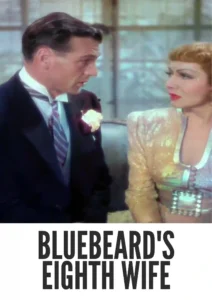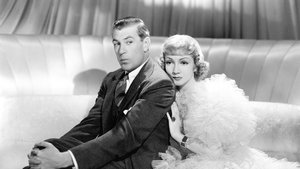Contact: info@alwanfilm.com
Video Sources 0 Views
- Watch trailer
- Bluebeard's Eighth Wife


Synopsis
Table of Contents
ToggleReview: Bluebeard’s Eighth Wife 1938 Colorized – A Classic Romantic Comedy Sparkling with Wit and Charm

Introduction
“Bluebeard’s Eighth Wife” (1938) is a delightful romantic comedy that continues to enchant audiences with its clever humor and timeless charm. In this article, we’ll explore the significance of this early colored film and its enduring appeal in the realm of romantic comedy.
Check The Full Colorized Movies List
Check Our Colorized Movies Trailer Channel
Understanding Bluebeard’s Eighth Wife 1938 Colorized: Director, Cast, and Genre
Directed by the esteemed Ernst Lubitsch, “Bluebeard’s Eighth Wife” (1938) showcases his mastery of the romantic comedy genre, blending sophisticated wit with heartfelt romance. The film features a stellar cast, including Gary Cooper and Claudette Colbert, whose on-screen chemistry crackles with energy and charm. Set against the backdrop of the French Riviera, “Bluebeard’s Eighth Wife” (1938) offers a delightful escape into a world of high society hijinks and romantic intrigue.
Exploring the World of Bluebeard’s Eighth Wife 1938 Colorized: Plot and Characters
At its core, “Bluebeard’s Eighth Wife” (1938) follows the misadventures of a wealthy American playboy, played by Gary Cooper, and a strong-willed Frenchwoman, portrayed by Claudette Colbert, whose whirlwind romance is put to the test by a series of comedic misunderstandings. As they navigate the pitfalls of love and marriage, they discover that true happiness lies not in wealth or status, but in the laughter and love they share together.
The Art of Film Colorization
Film colorization serves as a transformative tool that enhances the visual experience of classic movies, breathing new life into timeless stories and captivating audiences with vibrant hues. By digitally adding color to black and white films, colorization allows viewers to immerse themselves in the rich tapestry of cinematic worlds, exploring every nuance and detail with fresh eyes and renewed appreciation.
Early Colored Films: A Brief History
The history of colored films traces its roots back to the early days of cinema, with filmmakers experimenting with various techniques to add color to their creations. From hand-tinted frames to early Technicolor processes, the evolution of colored film has been marked by innovation and ingenuity, paving the way for the development of modern colorization techniques that continue to captivate audiences to this day.
Bluebeard’s Eighth Wife 1938 and Its Early Colored Version
The decision to release “Bluebeard’s Eighth Wife” (1938) in a colorized format was met with both anticipation and trepidation. While some welcomed the opportunity to experience the film in vibrant color, others expressed concerns about the potential impact on its visual aesthetic. Nevertheless, the early colored version of “Bluebeard’s Eighth Wife” (1938) offers viewers a fresh perspective on the classic romantic comedy, enhancing its timeless appeal and bringing its beloved characters to life in vivid detail.
The Debate Over Film Colorization
The debate over film colorization continues to divide audiences and critics alike, with proponents praising its ability to breathe new life into classic movies and introduce them to a new generation of viewers, while detractors argue that it compromises the artistic integrity of the original work and diminishes its historical significance. As the debate rages on, filmmakers and audiences alike are left to ponder the merits and drawbacks of colorization in the ever-evolving landscape of cinema.
Examining Bluebeard’s Eighth Wife 1938 as an Early Colored Film
As with any colorized classic, the impact of colorization on Bluebeard’s Eighth Wife 1938 Colorized is a matter of personal interpretation. Some may argue that it enhances the film’s visual appeal and immerses viewers in its world, while others may feel that it detracts from the stark beauty of the original black and white version. Regardless of one’s stance on the issue, there’s no denying the enduring power of “Bluebeard’s Eighth Wife” (1938) as a timeless romantic comedy that continues to capture the hearts of audiences around the world.
Influence and Legacy: Bluebeard’s Eighth Wife 1938 Colorized Impact on Cinema
“Bluebeard’s Eighth Wife” (1938) has left an indelible mark on the world of cinema, inspiring countless filmmakers and captivating audiences with its timeless humor and irresistible charm. From its witty dialogue to its sparkling performances, the film continues to resonate with viewers of all ages, reaffirming its status as a beloved classic of the romantic comedy genre.
Director’s Cinematic Legacy: Beyond Bluebeard’s Eighth Wife 1938 Colorized
Ernst Lubitsch’s influence extends far beyond “Bluebeard’s Eighth Wife” (1938), with a diverse body of work that continues to captivate audiences around the globe. From “Ninotchka” to “The Shop Around the Corner,” Lubitsch’s films are celebrated for their wit, sophistication, and timeless appeal, solidifying his legacy as one of the preeminent directors of Hollywood’s Golden Age. Through his groundbreaking work, Lubitsch has left an indelible imprint on the world of cinema, inspiring generations of filmmakers to follow in his footsteps.
Themes Explored in Bluebeard’s Eighth Wife 1938 Colorized
“Bluebeard’s Eighth Wife” (1938) explores a myriad of themes, from the complexities of love and marriage to the nature of wealth and privilege. Through its witty dialogue and charming characters, the film invites viewers to ponder the universal truths of human relationships and the enduring power of laughter to conquer even the greatest of obstacles. As audiences immerse themselves in the world of “Bluebeard’s Eighth Wife” (1938), they are reminded of the timeless wisdom and joy that love brings into our lives.
Reception and Controversy Surrounding Bluebeard’s Eighth Wife 1938 Colorized
Upon its release, “Bluebeard’s Eighth Wife” (1938) received widespread critical acclaim, with many praising its sparkling wit, charming performances, and timeless humor. However, the decision to release the film in a colorized format sparked debate among purists, reigniting the age-old discussion surrounding film preservation and artistic integrity. Despite the controversy, “Bluebeard’s Eighth Wife” (1938) remains a beloved classic that continues to enchant audiences with its wit and charm, reaffirming its status as a timeless masterpiece of the romantic comedy genre.
Where to Watch Bluebeard’s Eighth Wife 1938 Colorized Online
For those eager to experience the timeless magic of “Bluebeard’s Eighth Wife” (1938), the film is readily available on popular streaming platforms such as Netflix, Amazon Prime, and Hulu. Whether you choose to watch it in its original black and white format or the early colored version, “Bluebeard’s Eighth Wife” (1938) promises to transport you to a world of romance and laughter, where love conquers all and laughter is the best medicine.
FAQs About Bluebeard’s Eighth Wife 1938 Colorized
Q: Is “Bluebeard’s Eighth Wife” (1938) based on a true story? A: No, “Bluebeard’s Eighth Wife” (1938) is a fictional romantic comedy crafted by screenwriter Charles Brackett, who drew inspiration from classic tales of mistaken identity and romantic intrigue.
Q: Who are the main actors in “Bluebeard’s Eighth Wife” (1938)? A: “Bluebeard’s Eighth Wife” (1938) features a talented ensemble cast led by the charismatic Gary Cooper and the effervescent Claudette Colbert, whose on-screen chemistry lights up the screen with wit and charm.
Q: What awards did “Bluebeard’s Eighth Wife” (1938) win? A: While “Bluebeard’s Eighth Wife” (1938) did not win any major awards, it received critical acclaim for its sparkling wit, charming performances, and timeless humor.
Q: Why was “Bluebeard’s Eighth Wife” (1938) released in a colorized format? A: The decision to release “Bluebeard’s Eighth Wife” (1938) in color was made to introduce the film to a new generation of viewers and enhance its visual appeal for modern audiences. While the choice to colorize the film sparked debate among purists, it ultimately allowed “Bluebeard’s Eighth Wife” (1938) to reach a wider audience and ensure its continued relevance in the annals of cinematic history.
Conclusion
“Bluebeard’s Eighth Wife” (1938) remains a timeless classic that continues to captivate audiences with its sparkling wit, charming performances, and timeless humor. Whether viewed in its original black and white format or the early colored version, the film promises to transport viewers to a world of romance and laughter, where love conquers all and laughter is the best medicine.
Through its witty dialogue and charming characters, “Bluebeard’s Eighth Wife” (1938) reminds us of the enduring power of love and laughter to brighten even the darkest of days, reaffirming its status as a beloved classic of the romantic comedy genre.











